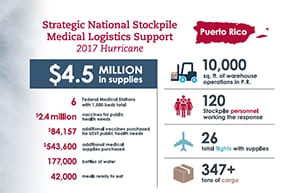Hurricane Stories From the Field

Caring for Displaced People in Houston
Federal Medical Station strike teams—teams of logistics experts deployed to assist with set up—arrived in Houston, TX, just hours after Hurricane Harvey made landfall. According to Steve Holland, a member of one of the strike teams, “Once we received orders to move the supplies to Houston, our Strategic National Stockpile liaison coordinated with the Bureau of Alcohol, Tobacco, Firearms, and Explosives to plan a route for us. But the plan continued to change because roads were flooding and often had to be closed. What would have been a 3-hour drive on a normal day took nearly 13 hours because of flooded roads.”
The strike team unpacked and setup the Federal Medical Station in Houston’s George R. Brown Convention Center in just 5 hours, a task that usually takes 10 hours to 12 hours. Martha Mock, a CDC emergency management specialist serving on the strike team recalls, “Within an hour, patients started receiving care while we continued to set up.” The convention center was used as a Federal Medical Station site that ultimately cared for 160 people displaced by Hurricane Harvey who were in need of non-emergency medical care.
Educating Children After Hurricane Maria
Hurricane Maria and Hurricane Irma hit the Caribbean in September 2017. In their aftermath, teachers in the U.S. Virgin Islands (USVI) talked about how many of the books in their classrooms were moldy and how teachers and staff had to help the janitorial staff clean up classrooms. Parents shared stories of their children coming home from school with mosquito bites all over their arms and legs.
CDC responder Malaika Washington worked with officials from the USVI Department of Health, the USVI Department of Education, and CDC Foundation to print and distribute information packets to more than 16,000 K-12 students on St. Croix, St. Thomas, and St. John to take home to their families. The packets included CDC-developed materials about how to stay safe after a hurricane that students could share with their families. Washington also visited kindergarten and first grade classrooms on St. Croix to read the Ready Wrigley Flooding and Mold Activity Book and hear the students’ stories and experiences after the hurricane. She reflected, “Children are the key to primary prevention because they are the drivers of the health behaviors we hope to change.”
Returning Home After the Storm
Vitelio Silva works for CDC’s Strategic National Stockpile (SNS) as a logistics management specialist. However, even after decades in a career that has been dedicated to disaster relief and coordination he was not prepared for what he experienced during the 2017 Hurricane Response. Silva grew up in Puerto Rico and was struck by the harsh reality of Hurricane Maria’s impact as his plane approached San Juan’s International Airport. From 5,000 feet above the ground, he saw the devastation his beautiful emerald island had suffered. All of the blue beach coves that he had previously used to help orient his location had been destroyed by long muddy run-offs from the flooding. As the plane made its final descent Silva saw familiar neighborhoods that were underwater.
Silva was one of the first CDC responders to deploy to the island after Hurricane Maria made landfall in September 2017. He served as the Strategic National Stockpile liaison and was responsible for taking care of Stockpile responders, supporting ASPR and CDC response goals, and collaborating with local and federal agencies to ensure that supplies from the Stockpile went to where they were needed most. Over 343 tons of cargo made it to Puerto Rico, including six Federal Medical Stations with 1,500 beds, 177,000 bottles of water and 42,000 meals ready to eat. The SNS also coordinated the purchase and delivery of over $540,000 worth of medical supplies and $2.1 million for vaccines to meet public health needs.
The hard work and expertise of the SNS in responses like the one in Puerto Rico helps prepare CDC to support our partners and provide the right materials, at the right time, to secure our nation’s health. Silva reflects, “We have gotten good at responding to this type of disaster when they happen — SNS employees and contractors rush to help, most of them willing to make sacrifices under very harsh conditions to help those who are in need.”